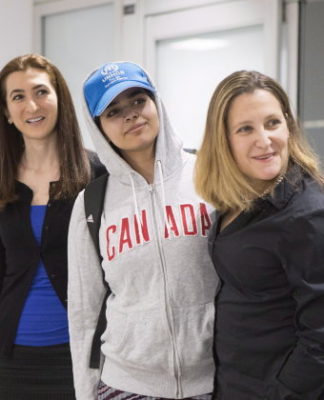‘Repurposed’ drug that could prevent breast cancer to be offered to nearly 300,000 women
The NHS estimates 2,000 cases would be prevented if 25% of eligible women in England take up the offer – and half of those take the drug for the recommended five years.
By Narbeh Minassian, news reporter
Tuesday 7 November 2023 12:38, UK
Breast cancer is one of the forms of the disease to see a fall in cases1:30
Play Video – Preventative breast cancer drug explained
What is anastrozole?
Why you can trust Sky News
A “repurposed” drug that could prevent breast cancer as well as treat it will be offered to almost 300,000 women, NHS officials have revealed.
Anastrozole has been used to treat hormone-sensitive breast cancer.
But trials have shown it can also stop the disease from occurring in the first place. It’s predicted cases could be cut by by 49% over 11 years.
The drug will be offered to 289,000 post-menopausal women who are considered to have at least a moderate risk of breast cancer in England.
“This is the first drug to be repurposed though a world-leading new programme to help us realise the full potential of existing medicines in new uses to save and improve more lives,” NHS chief executive Amanda Pritchard said.
Anastrozole was first recommended as a preventive option by the National Institute for Health and Care Excellence (Nice) in 2017, but, with the drug unlicensed in this use, uptake remained low.
Now scientists have found the protective effect lasts for years after a woman has stopped taking the drug – and has been licensed by the Medicines and Healthcare products Regulatory Agency .
Lesley-Ann Woodhams, who has a family history of the condition, completed the full five-year course of anastrozole in January 2023 and described it as a “gift”.
Lesley-Ann Woodhams has a history of breast cancer in her family
Image:
Lesley-Ann Woodhams has a history of breast cancer in her family
“I’d watched my mum battle breast cancer and my risk was very high,” she said.
“I could live a life without constantly worrying or giving a thought to what could be if I’d developed breast cancer.
“It really was a gift, it gave my family and myself peace of mind and more importantly, a continued future to look forward to.”
BREAST CANCER IS BRITAIN’S MOST COMMON – WHICH IS WHY THIS IS IMPORTANT
Ashish Joshi
Health correspondent
@ashishskynews
Breast cancer is Britain’s most common cancer with nearly 50,000 new cases discovered every year and that’s why the repurposing of anastrozole is so important.
Previously the drug was licensed for use in this country only as a treatment – not a preventive measure.
Trials show the drug reduces breast cancer cases by 49% over 11 years among eligible women.
These are post-menopausal women in their 50s and 60s who are deemed at moderate or higher risk of breast cancer.
This cohort includes women with a family history of the disease and women with BRCA1 and BRCA2 gene mutations who are more likely to get breast cancer than other women.
A significant family history means breast cancer can be diagnosed in family members at younger ages, or in several family members.
Eligible pre-menopausal women will still be offered tamoxifen, as per NICE guidance.
The most effective option for preventing breast cancer in women with BRCA mutations is mastectomy: surgery to remove the breasts.
If a quarter of eligible women take it up and half of those take the drug for the recommended five years then 2,000 cases of breast cancer could be prevented in England.
Anastrozole is only for post-menopausal women as it can’t antagonise the effects of high levels of ovarian oestrogen produced in pre-menopausal women.
In contrast, tamoxifen can block the effects of this oestrogen effectively.
Tamoxifen is not recommended in post-menopausal women with a uterus because it can cause more serious side effects in this group.
How does it work?
The treatment is taken as a 1mg tablet, once a day for five years and works by cutting down the amount of oestrogen the body makes by blocking an enzyme called aromatase.
The most common side effects of the medicine are hot flushes, feeling weak, pain or stiffness in the joints, arthritis, skin rash, nausea, headache, osteoporosis, and depression.
Breast cancer is the most common cancer in England, with around 47,000 women in England diagnosed each year.
Baroness Delyth Morgan, chief executive at the charity Breast Cancer Now, said the move is a “major step forward” that will enable more women to reduce their chance of developing the disease.
BREAST CANCER SYMPTOMS
You should see a GP if you notice any of the following:
• a new lump or area of thickened tissue in either breast that was not there before;
• a change in the size or shape of one or both breasts;
• a discharge of fluid from either nipple;
• a lump or swelling in either armpit;
• a change in the look or feel of skin, such as puckering or dimpling, a rash or redness;
• a rash (like eczema), crusting, scaly or itchy skin or redness on or around the nipple;
• a change in the appearance of a nipple, such as becoming sunken into the breast.
Health Minister Will Quince said: “We’ve already seen the positive effect anastrozole can have in treating the disease when it has been detected in post-menopausal women and now we can use it to stop it developing at all in some women.”
The moves adds to the NHS’s armoury of preventative breast cancer medication, with tamoxifen and raloxifene already licensed to prevent breast cancer.
Read more from Sky News:
Most people can’t identify lesser-known breast cancer symptoms
Cervical cancer treatment breakthrough could cut deaths by 35%
Surgeons carry out caesarean and ovaries removal at same time to cut cancer risk
3:11
Play Video – Poem shows how to check for breast lumps
Poem shows how to check for breast lumps
According to the NHS, the first symptom of breast cancer most women notice is a lump or an area of thickened tissue in their breast.
Most breast lumps are not cancerous, but it’s always best to have them checked by a doctor, officials say.






























